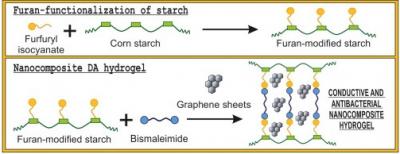The Materials+ Technology research group at the UPV/EHU’s Faculty of Engineering has, in collaboration with the University of Strasbourg, developed unique hydrogels with potential biomedical applications. Starch was used as the raw material and a 3D network structure was produced. When graphene and salvia extracts were added, the hydrogel was provided with electrical properties as well as the necessary antibacterial ones.

Hydrogels are physical and chemical polymer networks capable of retaining large quantities of liquid in aqueous conditions without losing their dimensional stability. They are used in a various applications and when various components are added to them, they acquire specific properties. This was the path followed by the research team, that selected a rather surprising biopolymer for its hydrogel: starch. One of our lines of research focuses on starch and we regard it as having biological, and physical and chemical properties suitable for producing hydrogels, said Kizkitza Gonzalez-Munduate, a member of the group.
The hydrogels developed address these demands very well, explained the team. To provide the hydrogel with electrical conductivity, they turned to graphene, that provides electrical properties that are highly suited to the hydrogel, but this also has a drawback: it is not easily stabilized in water. They used extracts of salvia to overcome this obstacle and to render the graphene stable in an aqueous medium. These extracts also make the hydrogel even more suitable for use in medicine as it also has antimicrobial and anti-inflammatory properties.
Another of the distinctive features of this research was the use of so-called click chemistry to produce the hydrogel. It is a strategy that in recent years has been grabbing the attention of the scientific community, because, unlike other means of synthesis, click chemistry does not tend to use catalysts in the reactions; in addition, no by-products are generated and they are high-performance reactions, said the researcher Gonzalez.
Although this product was designed for a very specific application, the researchers recognize that this product of bioengineering has a long way to go until it can be used in patients. It was a piece of research at an initial level focusing on the engineering side relating to the material. Now, the various levels will have to be overcome and the corresponding tests designed.